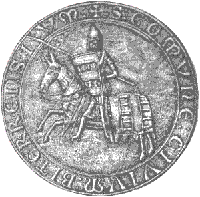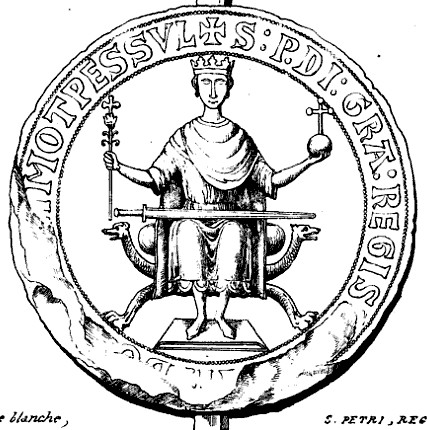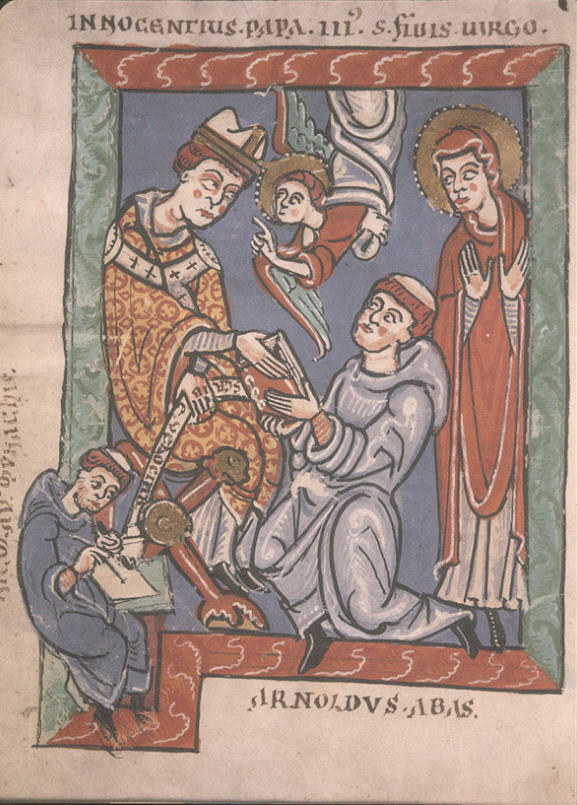|
Raymond Roger Trencavel
Raymond Roger Trencavel (also Raimond, oc, Raimon Rogièr; 1185 – 10 November 1209) was a member of the noble Trencavel family. He was viscount of Béziers and Albi (and thus a vassal of the count of Toulouse), and viscount of Carcassonne and the Razès (and thus a vassal of the count of Barcelona, which was also ruling Aragon at this time). Raymond-Roger was the son of Roger II Trencavel (d. 1194), and of Azalais of Toulouse (also known as the "Countess of Burlats"), daughter of Raymond V of Toulouse and sister of Raymond VI. Raymond-Roger was married to Agnes of Montpellier. His aunt, Beatrice of Béziers, was the second wife of Raymond VI of Toulouse. Raymond-Roger lived in the Château Comtal in the fortified hill town of Carcassonne. The château was built by his ancestors in the 11th century. Raymond-Roger was not a Cathar, although many of his subjects were. He adopted a ''laissez-faire'' attitude to Catharism – and to other cultures and religions. He relied st ... [...More Info...] [...Related Items...] OR: [Wikipedia] [Google] [Baidu] |
Trencavel
The Trencavel was an important noble family in Languedoc between the 10th and 13th centuries. The name "Trencavel" began as a nickname and later became the family's surname. The name may derive from the Occitan words for "Nutcracker" (''trenca avelana''). The name was traditionally restricted in actual use only to those family members named Raymond, but the last Trencavel viscount, Raymond II, preferred the surname over his given name and adopted it for his charters. The first well-known member of the family was Ato I, viscount of Albi in the early 10th century. He was followed by five generations of viscounts of Albi in direct father-to-son descent. During this same period the family came to dominate the episcopacy of Languedoc. Each of the viscounts from Ato II on had a younger brother named Frotarius (or Frothaire) who was a bishop, be it of Albi, Cahors, or Nîmes. History In 1069, the three daughters of Peter II of Carcassonne sold the Counties of Carcassonne, Razè ... [...More Info...] [...Related Items...] OR: [Wikipedia] [Google] [Baidu] |
Albigensian Crusade
The Albigensian Crusade or the Cathar Crusade (; 1209–1229) was a military and ideological campaign initiated by Pope Innocent III to eliminate Catharism in Languedoc, southern France. The Crusade was prosecuted primarily by the French crown and promptly took on a political aspect. It resulted in the significant reduction of practicing Cathars and a realignment of the County of Toulouse with the French crown. The distinct regional culture of Languedoc was also diminished. The Cathars originated from an anti-materialist reform movement within the Bogomil churches of the Balkans calling for what they saw as a return to the Christian message of perfection, poverty and preaching, combined with a rejection of the physical to the point of starvation. The reforms were a reaction against the often perceived scandalous and dissolute lifestyles of the Catholic clergy in southern France. Their theology, neo-Gnostic in many ways, was basically dualistic cosmology, dualist. Several of the ... [...More Info...] [...Related Items...] OR: [Wikipedia] [Google] [Baidu] |
1185 Births
Year 1185 ( MCLXXXV) was a common year starting on Tuesday (link will display the full calendar) of the Julian calendar. Events By place Byzantine Empire * August – King William II (the Good) lands in Epirus with a Siculo-Norman expeditionary force of 200 ships and 80,000 men (including 5,000 knights), and marches as far as the Byzantine city of Thessalonica, which he takes and pillages (massacring some 7,000 Greek citizens). * September 11– 12 – Isaac II (Angelos) leads a revolt in Constantinople and deposes Emperor Andronikos I (Komnenos). Andronikos tries in vain to flee across Asia – but he is captured and killed by an angry mob. Isaac is proclaimed emperor, ending the Komnenos Dynasty. * November 7 – Battle of Demetritzes: A reinforced Byzantine army under Alexios Branas decisively defeats William II – ending his invasion of the Byzantine Empire. Thessalonica is recaptured, and the Normans are pushed back to Italy. Many Norman ships ... [...More Info...] [...Related Items...] OR: [Wikipedia] [Google] [Baidu] |
Louis IX Of France
Louis IX (25 April 1214 – 25 August 1270), commonly known as Saint Louis or Louis the Saint, was King of France from 1226 to 1270, and the most illustrious of the Direct Capetians. He was crowned in Reims at the age of 12, following the death of his father Louis VIII Louis VIII (5 September 1187 – 8 November 1226), nicknamed The Lion (french: Le Lion), was King of France from 1223 to 1226. As prince, he invaded England on 21 May 1216 and was excommunicated by a papal legate on 29 May 1216. On 2 June 1216 .... His mother, Blanche of Castile, ruled the kingdom as regent until he reached maturity, and then remained his valued adviser until her death. During Louis' childhood, Blanche dealt with the opposition of rebellious vassals and secured Capetian success in the Albigensian Crusade, which had started 20 years earlier. As an adult, Louis IX faced recurring conflicts with some of his realm's most powerful nobles, such as Hugh X of Lusignan and Peter of Dreux. Simult ... [...More Info...] [...Related Items...] OR: [Wikipedia] [Google] [Baidu] |
Raymond II Trencavel
Raymond II Trencavel (also spelled Raimond; 1207 – 1263/1267) was the last ruler of the branch of the Trencavel viscounts of Béziers. His entire life was occupied by efforts to reverse the downfall the Trencavel had experienced during the Albigensian Crusade, but he ultimately failed. Raymond was only two years old when his father, Raymond Roger, died in prison on 10 November 1209. He would have automatically inherited the viscounties of Béziers, Carcassonne, Albi, and Razès, but Carcassonne was granted to Simon de Montfort immediately after Raymond Roger's death and Albi was granted to him in June 1210.Graham-Leigh, 44. On 25 November 1209, Agnes, Raymond's mother and guardian, relinquished her dowry in the Pézenas and Tourbes, which would have gone to Raymond, to Simon in exchange for a pension of 3,000 ''solidi'' annually and compensation of 25,000 ''solidi'' for her dowry, to be made in four annual payments. When Raymond was only three, his mother negotiated the surr ... [...More Info...] [...Related Items...] OR: [Wikipedia] [Google] [Baidu] |
Simon De Montfort, 5th Earl Of Leicester
{{Infobox noble , name = Simon de Montfort , title = 5th Earl of Leicester , image = File:Simon4demontfort.gif , caption = Seal of Simon de Montfort, depicting him riding a horse and blowing a hunting horn with a hound alongside, inscribed with his Latinised name: ''SIGILL MSIMONIS DE MONTE FORTI ("seal of Simon from the strong mountain") , alt = , CoA = , more = no , succession = , reign = , reign-type = , predecessor = , successor = , suc-type = , spouse = Alix de Montmorency , spouse-type = , issue = Amaury de MontfortSimon de Montfort, 6th Earl of LeicesterGuy de Montfort, Count of Bigorre Amicie de MontfortPetronilla , issue-link = , issue-pipe = , full name = , native_name = , styles = , other_titles = , noble family = Mon ... [...More Info...] [...Related Items...] OR: [Wikipedia] [Google] [Baidu] |
Poison
Poison is a chemical substance that has a detrimental effect to life. The term is used in a wide range of scientific fields and industries, where it is often specifically defined. It may also be applied colloquially or figuratively, with a broad sense. Whether something is considered a poison may change depending on the amount, the circumstances, and what living things are present. Poisoning could be accidental or deliberate, and if the cause can be identified there may be ways to neutralise the effects or minimise the symptoms. In biology, a poison is a chemical substance causing death, injury or harm to organisms or their parts. In medicine, poisons are a kind of toxin that are delivered passively, not actively. In industry the term may be negative, something to be removed to make a thing safe, or positive, an agent to limit unwanted pests. In ecological terms, poisons introduced into the environment can later cause unwanted effects elsewhere, or in other parts of the food ... [...More Info...] [...Related Items...] OR: [Wikipedia] [Google] [Baidu] |
Dysentery
Dysentery (UK pronunciation: , US: ), historically known as the bloody flux, is a type of gastroenteritis that results in bloody diarrhea. Other symptoms may include fever, abdominal pain, and a feeling of incomplete defecation. Complications may include dehydration. The cause of dysentery is usually the bacteria from genus ''Shigella'', in which case it is known as shigellosis, or the amoeba ''Entamoeba histolytica''; then it is called amoebiasis. Other causes may include certain chemicals, other bacteria, other protozoa, or parasitic worms. It may spread between people. Risk factors include contamination of food and water with feces due to poor sanitation. The underlying mechanism involves inflammation of the intestine, especially of the colon. Efforts to prevent dysentery include hand washing and food safety measures while traveling in areas of high risk. While the condition generally resolves on its own within a week, drinking sufficient fluids such as oral rehydration s ... [...More Info...] [...Related Items...] OR: [Wikipedia] [Google] [Baidu] |
Dungeon
A dungeon is a room or cell in which prisoners are held, especially underground. Dungeons are generally associated with medieval castles, though their association with torture probably belongs more to the Renaissance period. An oubliette (from french ''oublier'' meaning to ''forget'') or bottle dungeon is a basement room which is accessible only from a hatch or hole (an ''angstloch'') in a high ceiling. Victims in oubliettes were often left to starve and dehydrate to death, making the practice akin to—and some say an actual variety of—immurement. Etymology The word ''dungeon'' comes from French ''donjon'' (also spelled ''dongeon''), which means "keep", the main tower of a castle. The first recorded instance of the word in English was near the beginning of the 14th century when it held the same meaning as ''donjon''. The proper original meaning of "keep" is still in use for academics, although in popular culture it has been largely misused and come to mean a cell or "oubliet ... [...More Info...] [...Related Items...] OR: [Wikipedia] [Google] [Baidu] |
Pope Innocent III
Pope Innocent III ( la, Innocentius III; 1160 or 1161 – 16 July 1216), born Lotario dei Conti di Segni (anglicized as Lothar of Segni), was the head of the Catholic Church and ruler of the Papal States from 8 January 1198 to his death in 16 July 1216. Pope Innocent was one of the most powerful and influential of the medieval popes. He exerted a wide influence over the Christian states of Europe, claiming supremacy over all of Europe's kings. He was central in supporting the Catholic Church's reforms of ecclesiastical affairs through his decretals and the Fourth Lateran Council. This resulted in a considerable refinement of Western canon law. He is furthermore notable for using interdict and other censures to compel princes to obey his decisions, although these measures were not uniformly successful. Innocent greatly extended the scope of the Crusades, directing crusades against Muslim Iberia and the Holy Land as well as the Albigensian Crusade against the Cathars in southern ... [...More Info...] [...Related Items...] OR: [Wikipedia] [Google] [Baidu] |
Peter II Of Aragon
Peter II the Catholic (; ) (July 1178 – 12 September 1213) was the King of Aragon and Count of Barcelona from 1196 to 1213. Background Peter was born in Huesca, the son of Alfonso II of Aragon and Sancha of Castile. In 1205 he acknowledged the feudal supremacy of the papacy and was crowned in Rome by Pope Innocent III, swearing to defend the Catholic faith (hence his epithet, "the Catholic"). He was the first king of Aragon to be crowned by the pope. In the first decade of the thirteenth century Peter commissioned the ''Liber feudorum Ceritaniae'', an illustrated codex cartulary for the counties of Cerdagne, Conflent, and Roussillon. Marriage On 15 June 1204 Peter married (as her third husband) Marie of Montpellier, daughter and heiress of William VIII of Montpellier by Eudocia Comnena. She gave him a son, James, but Peter soon repudiated her. Marie was popularly venerated as a saint for her piety and marital suffering, but was never canonized; she died in Rome in 1 ... [...More Info...] [...Related Items...] OR: [Wikipedia] [Google] [Baidu] |
Arnaud Amaury
Arnaud Amalric ( la, Arnoldus Amalricus; died 1225) was a Cistercian abbot who played a prominent role in the Albigensian Crusade. It is reported that prior to the massacre of Béziers, Amalric, when asked how to distinguish Cathars from Catholics, responded, "Kill them ll for God knows which are His own." Early life He was abbot of Poblet in Catalonia from 1196 to 1198, then of Grandselve from 1198 to 1202.Tugwell, Simon. ''Early Dominicans''. Paulist Press. . 1982. p 114-115. He then became the seventeenth abbot of Cîteaux (until 1212). Albigensian Crusade In 1204, he was named a papal legate and inquisitor and was sent by Pope Innocent III with Peter of Castelnau and Arnoul to attempt the conversion of the Albigensians. Failing, he distinguished himself by the zeal with which he incited men by his preaching to the crusade against them. He was in charge of the crusader army that sacked Béziers in 1209. There, according to the Cistercian writer Caesarius of Heisterbac ... [...More Info...] [...Related Items...] OR: [Wikipedia] [Google] [Baidu] |










